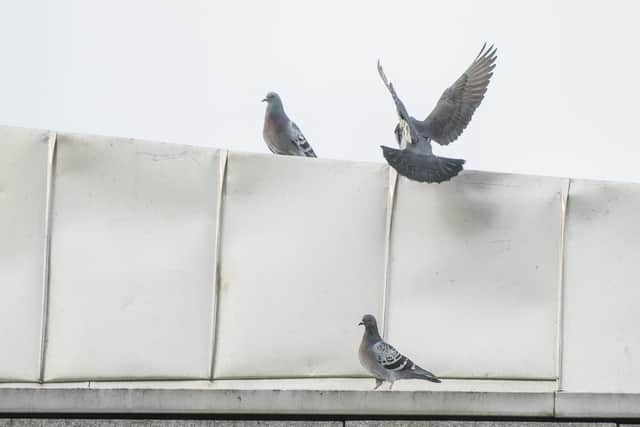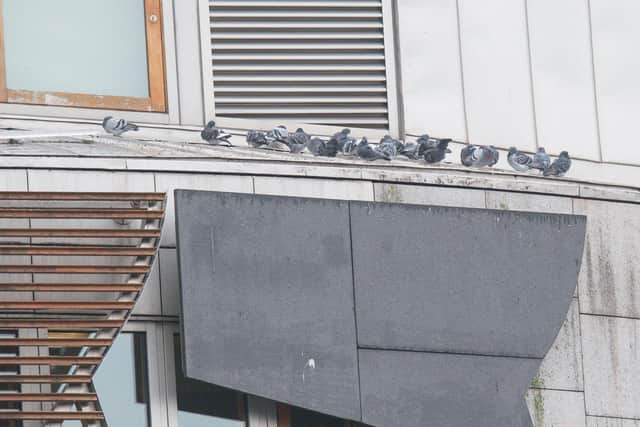Scottish Parliament pigeon numbers cut by new deterrent measures
and live on Freeview channel 276
New anti-pigeon measures at the Scottish Parliament have helped permanently reduce the number of the birds plaguing the site, contractors have claimed.
Pigeons have been a persistent problem at the £414 million Holyrood building right from the start. When wires, nets and spikes at various places around the campus failed to deter them, hawks and falcons were brought in to scare them away. Contractors fly the birds of prey several times a month at the parliament and pigeon numbers appear to have fallen. But certain parts of the campus – including the service yard and the MSP block – have proved difficult to rid of the birds.
Advertisement
Hide AdAdvertisement
Hide AdHowever, Avian Pest Solutions Ltd, which took over the contract in November 2021, said additional "proofing" measures have helped cut numbers further. The monthly report on the pigeon problem for March last year said the average number of pigeons seen on site when the contractor arrived to fly the hawks was 11 and the number counted on departure was three. The report said: "We believe the above numbers show that the netting in the service yard and upgrades to the proofing on the MSP Block has helped permanently displace even more resident birds."


The monthly reports show the number of pigeons seen at any one time around the service yard fell from a high of 15 in December 2021 to just one in October 2022. But the MSP block did not see such a dramatic reduction – down from a high of eight in April 2022 to six in October 2022.
And the next focus for attention could be the parliament’s towers, which house the committee rooms. One report noted this area was particularly attractive in cold weather. The report said: “Pigeons were extremely reluctant to leave site and instead, flocked together around the heat ventilators high on south east facing towers. We will also look at techniques to deter birds from the heat extraction areas around the towers.” A later report said they could try to combat the problem by flying a hawk in that area when appropriate and added: “Potential roof top falconry and potential deterrents to be discussed.”
The report for May 2022 said approval had been given for further proofing, which would help deter roosting birds from the front of the building. It added: “Once this is completed we will look to chase off any displaced birds.” Netting has also been installed on the flat area of Queensberry House and, according to the June 2022 report, “is having a great impact in denying roosting/nesting areas which are usually out of view”.
Advertisement
Hide AdAdvertisement
Hide AdAnother report described how the two regular hawks used at the parliament complemented each other to scare away the pigeons – “with one more likely to land on ledges and flush birds out and one (female), the larger bird, dominating the sky.”


The parliament has been a haven for pigeons since before it opened in October 2004 and was branded a “giant pigeon loft” because of all its nooks and crannies. Muck and feathers were blown through vents on to researchers' desks and some birds even got into MSPs' offices. At first, birds of prey were rejected as a suitable method of dealing with the nuisance. The parliament fixed bird wire to ledges as a deterrent but pigeons were then reported "trampolining" on the wires. Nets were used to stop birds getting into many of the recesses on the building before anti-roosting spikes – originally dismissed as "visually intrusive" – were also installed. Then, in late 2008, parliament officials announced birds of prey would be introduced after all. But there was a strict "no kill" policy. Officials warned in a report it would be a "PR disaster" if hawks were to start eating pigeons alive in front of visiting schoolchildren.
A Scottish Parliament spokesman said: “We use a range of measures to deter pigeons, but it’s unlikely any city-centre location will ever be completely successful.”